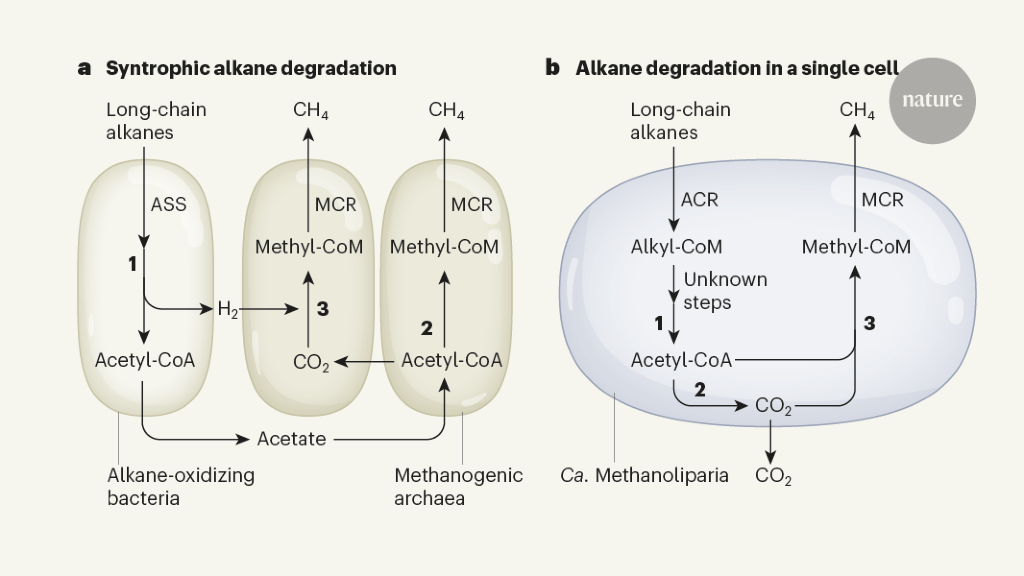NEWS AND VIEWS
22 December 2021 A microbe that uses crude oil to make methane A microorganism that dwells in an underground oil reservoir has been found to degrade various petroleum compounds and use them to produce methane through a previously unreported biochemical pathway. Guillaume Borrel ORCID: http://orcid.org/0000-0003-4893-8180 0 Guillaume Borrel Guillaume Borrel is in the Department of Microbiology, Evolutionary Biology of the Microbial Cell Unit, UMR2001, Institut Pasteur, Paris 75015, France. View author publications You can also search for this author in PubMed Google Scholar
Microbial communities tend to use the most energy-rich and most easily metabolized compounds that they have at their disposal. This leads to a progressive enrichment of compounds that are difficult to break down and that provide little energy, particularly in the absence of oxygen or other inorganic electron acceptors. Under these conditions, the use of hydrocarbons — molecules consisting of carbon and hydrogen, such as alkanes — has been thought to rely entirely on a collaboration (known as syntrophy) between bacteria that break down these compounds into acetate and molecular hydrogen (H 2 ), and microorganisms called methanogenic archaea that use the molecules to produce methane (CH 4 ), the simplest hydrocarbon1–3. Writing in Nature, Zhou et al.4 overturn this long-standing account of a division of labour in the methanogenic degradation of hydrocarbons by reporting that a single type of microorganism can degrade various large hydrocarbons into methane (Fig. 1).
doi: https://doi.org/10.1038/d41586-021-03729-3
References 1. Zengler, K., Richnow, H. H., Rosselló-Mora, R., Michaelis, W. & Widdel, F. Nature 401, 266–269 (1999). 2. Schink, B. Microbiol. Mol. Biol. Rev. 61, 262–280 (1997). 3. Jones, D. M. et al. Nature 451, 176–180 (2008). 4. Zhou, Z. et al. Nature https://doi.org/10.1038/s41586-021-04235-2 (2021). 5. Borrel, G. et al. Nature Microbiol. 4, 603–613 (2019). 6. Nobu, M. K., Narihiro, T., Kuroda, K., Mei, R. & Liu, W.-T. ISME J. 10, 2478–2487 (2016). 7. Vanwonterghem, I. et al. Nature Microbiol. 1, 16170 (2016). 8. Sorokin, D. Y. et al. Nature Microbiol. 2, 17081 (2017). 9. Söllinger, A. & Urich, T. Biochem. Soc. Trans. 47, 1895–1907 (2019). 10. Laso-Pérez, R. et al. mBio 10, e01814-19 (2019). 11. Laso-Pérez, R. et al. Nature 539, 396–401 (2016). 12. Chen, S.-C. et al. Nature 568, 108–111 (2019). 13. Hahn, C. J. et al. Science 373, 118–121 (2021). 14. Shima, S. et al. Nature 481, 98–101 (2012). Download references
Competing Interests The author declares no competing interests.
Related Articles
